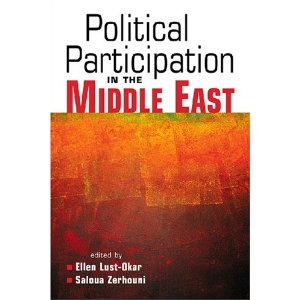|
Reviewed by Sarah E. Yerkes, Ph.D. Candidate, Georgetown University Department of Government Scholars writing on contemporary politics in the Middle East and North Africa (MENA) region have stopped asking, “Why is the Arab world not democratic?” (as Ghassan Salamé did in 1991) and instead started asking, “Why is the Arab world still autocratic?” That is, there is a consensus in the literature that the unique blend of autocracy and democracy that exists in the MENA region is a stable system of government that is no longer thought to be in transition to democracy. Thus, scholars have turned their attention to the MENA regimes themselves in an attempt to understand how Middle East leaders are able to manipulate the structures and actors within their polities in order to stay in power. Countering some of the more state or institution-centered approaches to the persistence of authoritarianism in the MENA region, Political Participation in the Middle East brings agency back in to the picture, focusing on why individuals in the MENA region choose to participate in the hollow democratic exercises taking place within their states. The book is a welcome contribution to the literature on the persistence of authoritarianism in the MENA region, offering a bridge between formal and informal modes of participation. As several of the chapters’ authors rightly argue, there has been an undue emphasis in the past on formal institutions (elections, political parties, and legislative bodies). This volume corrects this problem, both adding informal institutions to the picture of political participation in the MENA region and arguing for the study of formal and informal institutions as intersecting forces. The book is divided into three main parts, the first contains two chapters that provide a theoretical overview of political participation in the MENA region; the second section contains four chapters, each dealing with the electoral arena; and the third section contains five chapters on political participation outside of elections. The book covers a large swath of the region, with individual chapters on Iran, Jordan, Egypt, Gaza, Bahrain, Morocco, and Tunisia. While the various authors agree that political participation matters and is worthy of scholarly attention, they disagree on the more interesting and important questions: what constitutes participation, who participates, and why they participate. One of the stronger chapters, “Formal and Informal Venues of Engagement” by Laila Alhamad (chapter 3), broadens the definition of political participation to include informal modes of participation that are not necessarily intent on influencing government decision-making. She argues that the weak formal political institutions of the MENA region make participation there mostly irrelevant. This is a useful insight, and one which hopefully more scholars will develop in future research. On the subject of formal institutions, Ellen Lust-Okar’s chapter, “Competitive Clientalism in Jordanian Elections” (chapter 5) complements Alhamad’s chapter by arguing that while elections do not bring about government alternation, they are significant in that they provide voters the opportunity to compete for patronage resources, which she terms “competitive clientalism.” (p.75) This chapter, and others, thus reframe the lens through which scholars of the MENA region view formal institutions of political participation. Nevertheless, one question that remains after reading this book is why we should care about the participation of individuals in elections and political processes that are, in almost every sense, meaningless exercises, or façades put on by the regime to placate international democracy promoters and civil society actors at home. Holger Albrecht’s chapter (“The Nature of Political Participation”) makes this very point, arguing that there is no such thing as “meaningful mass participation” in the Middle East and that formal institutions do not “substantially affect the political, economic, and social life of the ordinary citizen.” (p.24) While he does point to the ability of citizens to participate in political life through informal channels, the examples he gives (through corporatist endeavors, informal social networks and oppositional political institutions autonomous from the state) each come with major caveats limiting the likelihood that individual citizens will be successful in using these channels to effectively challenge the government. |



